

Stacy Vellas writes:
"Between the towns of Hill City and Rabey, along the rail line, were the towns of Brauer and Washburn. My mother taught school at Rabey and she spoke of those towns often.
Rabey is on the map in the book "Beyond the Circle" by Leo Trunt. I had the pleasure to work with him on his book."

"THE VILLAGE OF RABEY"
Excerpt from "Beyond the Circle"
by Leo Trunt
Published with Permission of the Author
Transcribed by Karen Klennert
For Purchasing Information, Contact Leo Trunt

The village of Rabey got its start with the advent of the Mississippi, Hill City, and Western Railway Company's birth in 1908. Prior to that time, the village site of Rabey was low-lying ground and mostly swamp land. there is little evidence of any previous habitation either by the early Native Americans or others. There was some activity to the south and east with A. B. Feero and a few others who were penetrating the area with their logging efforts. To the north of Rabey was the Splithand community that was just getting started. Had there been no railroad through this country, the Rabey location would probably have been an extension of the Splithand area and may have only had a few farms at best. With the coming of the railroad, things changed dramatically.
The Rabey Line Railroad was under initial construction in 1908, but it took a year or so to get the ties in, the rail laid, and a decent ballasting of the road. Even though the cost of the railroad was in the neighborhood of $200,000, it was built in the least expensive way possible. Only forty pound rail were laid down, and they were used rails besides. The railroad was needed to get out the products of the Hill City Pail Factory, which was the main shipper over the line. No doubt, the railroad was only planned to last for a few decades or until the timber from the surrounding countryside was cut.
The railroad opened the northern part of Aitkin County for the development of farms which sprang up all along the line. Various stations were set up along the line to take advantage of the freight expected from farmers in the nearby lands. A potato warehouse was built on the north side of the track just to the east of Rabey and on the west side of the current River Road. A side track was built here as well. This location was called "Seaver". Seaver was named after the first general manager of the National Woodenware Plant in Hill City, J. H. Seaver. (Per The Rabey Line, by Robert Lemen)

Seaver Potato Warehouse on the left
Rabey Depot on right
Pictured after they were moved to the Michelson Farm.
Courtesy of Walter Koski
There were big plans for Seaver. "W. H. Taylor and H. V. Eastman are planning on establishing a general store at Seaver, this side of the Mississippi River. They have a petition in to have the post office at Jacobson moved to Seaver. The store will probably not be established until spring." (Hill City News ~ November 21, 1912) The petition was denied.
At that time, the farmers to the north and south of the line traveled along the high lands that led to Seaver and brought their produce to the station. The Seaver warehouse was the easiest way to get out the cash crops of potatoes and other grains and produce. While the Seaver warehouse had no agent or depot, the railroad made accommodations to serve the people of the area and get their produce to market. (Per letter from Pearl Michelson, dated October 5, 1996) The farmers of the region south of the grade and along the west side of the Mississippi River formed a co-operative and used the Seaver warehouse. They purchased a threshing machine and worked together to help each other and to try to improve their lot in life.

The Mississippi Threshing Company, 1943
Located at the Anton Anderson Farm just east of the Farmers Hall, Ball Bluff
Courtesy of Mike Bjorkquist
In 1922, the farmers formed the Mississippi Threshing Company. It was started with 23 families signing up. They would hire a couple of men to run the threshers. The crew would move up and down the river to the respective farms changing the direction of the threshing each year. In 1928, 7,571 bushels were thrashed. In 1951, the company bought a tractor and the co-operative operated until 1956 when it was dissolved. Another society formed was the Farmers Hall Society, which then became the Farmers Social and Educational Society in 1921. There was, as well, the Jacobson Co-op. It was quite successful and eventually was separated from the Wawina Co-op and went on its own.
Charles Kaiser and Warren Rabey built a potato warehouse at Rabey. This was a conscious effort to draw the farmers from the Splithand district as well as those in the immediate vicinity of Rabey. There were not many farmers to the south of Rabey despite the efforts of the dredges. The dredges came through in 1910 and helped the railroad by pulling off much of the water from the swamps that hampered the line. Without the help of the dredges, the roadbed would have been hopelessly water soaked to the point of being nearly unusable. As it was, the road suffered many derailments, and it was finally decided to haul heavy loads only in the winter when the grade froze and firmed up. The road gained the popular moniker of "The Muskeg Limited." (Per Ray Burt Recollections, May 23, 1980) "The Muskeg Limited, the train between Hill City and Swan River, has added an additional coach." (Grand Rapids Herald Review ~ July 21, 1915)

Rabey Store
Courtesy of Eileen Rasmussen Danson

Rabey Depot and Store
Looking east at Rabey.
The Store has an addition.
Potato Warehouse is behind Depot.
Courtesy of Eileen Rasmussen Danson
The depot at Rabey was built about 1909. A side track was placed on the south side of the main line. A railroad car was placed at Rabey to be used as a makeshift store. This was not satisfactory, and so Kaiser and Rabey built a general store of more substantial means that was finished in 1913. (Rabey History, by Sylvia Eckstrom) "At Rabey station, Chas. F. Kaiser and W. W. Rabey are putting up a building that will be occupied as a general store by V. R. Walker and Geo. A. Hankerson. Mr. Walker will be in charge of the store. The building, which is nearly completed, is 20 by 40 feet with 12 foot posts. A stock of general merchandise, groceries, dry goods, hardware, etc., will be carried in stock. The building will probably be completed in another week. Petitions are being circulated to have a post office established at this point.
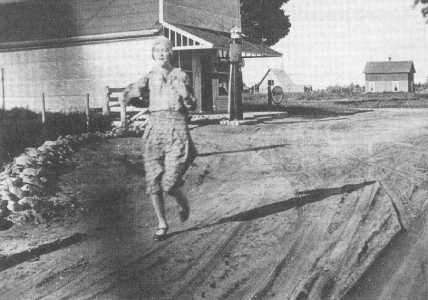
The Rabey General Store
Carrie Phillips pictured.
Roberts Place in Background.
Courtesy of Sylvia Eckstrom
"The Splithand settlers want to have connection with the railroad and desire a post office near at home and (are) pushing the matter along. A tote road now runs from Rabey to Splithand and this will be fixed up for use this winter." (Hill City News ~ November 21, 1912) Harold Eastman then took over the store and had a pole yard. (Per interview with Charlie and Granville VanDusen on November 7, 1995)
A railroad car was brought in and served as a bunk house for the workers of the Farm Development Company. Another car was used as a cook house and even a church. Mrs. John Phillips cooked for the men who worked for the company while they built the barns and other demonstration buildings. This company was owned jointly by Warren Rabey and Charles Kaiser. They were of the mind that if the farm lands of the Rabey district could be promoted and proven to be productive, then they would have an easier time convincing others to buy lands there and build up the area. This would also be good business for the railroad which they were involved in getting built through to Hill City. Not surprisingly, the town site was platted on December 29, 1917 by the Farm Development Company and was named for Mr. Rabey. (Plat of Rabey, Aitkin County Recorders Office.)
Trains were not the only mode of transportation over the railroad. A number of people used the rails as a means of transportation by using "speeders" and motorized vehicles that would run on the rail. Sometimes they also met with disastrous results. "In a collision between a hand speeder and a railway motor Saturday evening, Mrs. Chas. F. Kaiser received a bad cut on her head and was rendered unconscious and the other passengers received minor bruises and were badly shaken up.
"The 'motor' in charge of W. W. Rabey, had as passengers, Mrs. C. F. Kaiser and her sister-in-law, Mrs. J. D. Wilde, and was coming from Rabey to Hill City, endeavoring to get in ahead of the train. They were running at a good speed when they met the speeder ridden by E. E. Reynolds. In the darkness neither party saw the other until it was too late to avoid the smash-up.
"Mr. Reynolds managed to get clear of his machine and escaped with a shaking up and some minor bruises. His speeder was badly broken up. Mr. Rabey had just time to shut off his power and put on brakes when the crash came. He escaped unhurt but the ladies were thrown a distance of fifteen feet. Aside from some minor bruises Mrs. Wilde was uninjured, but Mrs. Kaiser was not so fortunate. She struck her head, cutting a bad gash in it and was rendered unconscious. She was attended by Dr. Stewart and it was found that her injuries were not as serious as it was first feared.
"The accident clearly points out that such things are within the range of possibility and that all speeders and motors should be equipped with lights for night travel." (Hill City News ~ October 14, 1914)
To the west of Rabey were a number of "spurs" or localities where pioneers were trying to take advantage of the railroad and the possibilities that were presented. Farmers moved into the area between Hill City and Rabey. Many tried farming, cutting timber to sell, or working for the various timber concerns.
Heading west, the first place one came to was a place known as "Pierceville." This was a siding that was on the north side of the track and headed to the northwest a short distance. Not much is known about this except that the Pierce Brothers ran a lath mill there for a few years. (The Rabey Line, by Robert Lemen, page 13) The next place one came to was Washburn Lake or "Washburn." Here Art and Earl Heath had a lath mill that they operated a few years. It was sold to Sander Olson who moved the mill to the southeast side of Washburn Lake and ran it for a time. A little over a mile north of Washburn was the Lange School named for the family by that name. On the southwest side of Washburn Lake was the Taskey School named for that family. It was also known as the Allen Lakes School.
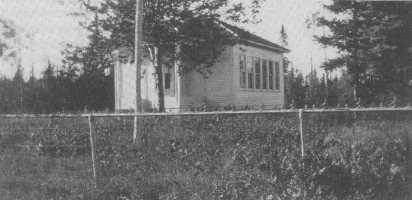
Lange School on Highway 34
Courtesy of Bill and Esther Lange
About two miles farther west of Washburn was the Martin Spur. The spur was extended off the Brauer side track, curving to the northeast for slightly more than a quarter mile, and was used to pick up logs spotted there by the Martin Brothers, hence the name of the spur. (The Rabey Line, by Robert Lemen, page 12) Here the Martin Brothers ran their logging camp. A few others lived and worked here, too. "Aug. Heyn has purchased a steam engine from Emil Suikola and is moving it to Martin's Spur where he will saw staves for the National Woodenware Co." (Hill City News ~ December 14, 1922) Others simply worked for the loggers. "Otto Weidiger, employed at the Charles Tasky logging camp at Martin Spur were Rabey callers."(Aitkin Republican ~ January 27, 1927) The Martin School was located near the spur. "Martin Spur School held a basket social Saturday night that netted $85.00. The proceeds will be used on the purchase of an organ for the school. Ten baskets were sold, the highest bringing $16.00. Besides Lula Noble, the teacher, Ruth Silkey, Margaret Frederick, Nellie Christensen, Myrtle Richared and Lawrence Taylor attended from here (Hill City). Dancing was the entertainment of the evening." (Hill City News ~ February 3, 1921)
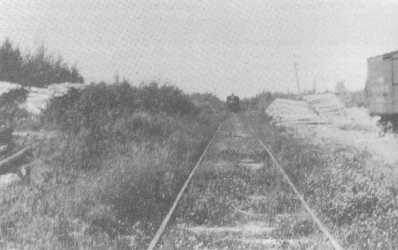
Martin Spur, Looking East
Courtesy of Bill and Esther Lange
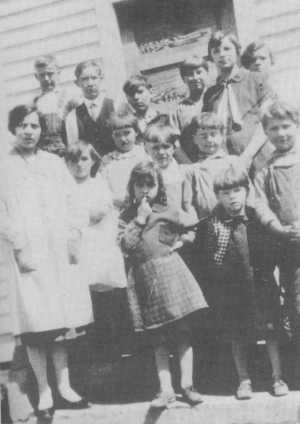
Martin Spur School, Class of 1925-26
Burt King is upper left with vest and tie.
Nick Kortekaas is right with his hands folded.
Neil Kortekaas is right of Nick with his eyes closed.
Courtesy of Bill and Esther Lange
Adjacent to the Martin Spur and to the west was the location called "Brauer." There was a spur here on the north side of the track heading west, and it was here that most of the development at Brauer occurred. "Mrs. Harold Eastman and children made a trip to Hill City Thursday, returning the following day. Mr. Eastman accompanied them as far as Brauer where he went to look after logging camps." (Grand Rapids Herald Review ~ December 27, 1916) The Brauer School was on the north side of the tracks while a few miles to the south was the Huddleston School. There was a general store in Brauer known as Jackman's Store. They carried the typical goods and also had boarders. This was the social center for the locality.
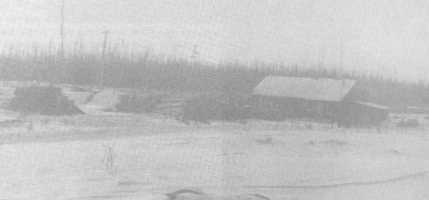
Brauer Spur, 1919
Courtesy of Bill and Esther Lange

Brauer School
Courtesy of Bill and Esther Lange
The people tried to have a bit of fun whenever they could. "A big dance is scheduled by J. M. Jackman at Brauer Spur on Saturday, June 26." (Hill City News ~ June 24, 1915) One holiday went something like this. "Hill City was not the only place to celebrate the 4th in a fitting manner. It was also observed at Brauer's Spur by a neighborhood picnic at Little Pine Island, the summer home of Mr. and Mrs. W. B. Chase. An old fashioned picnic dinner was served, which wound up with ice cream, lemonade, etc. After dinner came the sports and races.
"The nail driving contest was won by Mrs. J. Huddleston first, Mrs. Howard Anderson second, and Mrs. Otto Weidiger, third. The potato race was declared a tie between Otto Weidiger and Howard Anderson and a 50 yard dash was run to settle the matter. This was won by the former. John Pilgrim of Brauer won from Miss Jessie Milhouse of Minneapolis, in the potato peeling contest. In the tug of war between the farmers from Brauer and a crew from Minneapolis the farmers won after a hard tussle. Two egg races were next in order, the first being won by Kenneth Chase, second won by Roy Huddleston. The bean guessing contest ended as follows: Otto Weidiger first, W. B. Chase second, Mrs. Howard Anderson third. Howard Anderson gave a reading and W. B. Chase a short talk and a story which were all greatly enjoyed. A sewing contest was won by John Pilgrim first and W. B. Chase second. John says that he knows a thing or two about sewing, having done the sewing for his house for some years. In the shooting contest W. B. Chase and J. Huddleston carried off the honors among the men while the ladies showed that when it came to hitting the mark with a gun they knew how it was done. Mrs. Otto Weidiger and Mrs. Howard Anderson won the shooting. A ball game went to the Minneapolis boys, after which the dance was started.
"The ball was opened by a grand march led by Mr. and Mrs. W. B. Chase and soon after supper was served. At 9:45 the dancing commenced again and kept up all night. The last two boat loads leaving at 7:30 a.m. It is about four miles from Little Pine to Oak Point by way of Willow River, and the two boats raced for it. The race was won by J. Huddleston, and he says that John Pilgrim was so much overcome by his many honors won during the day and evening that it was not as hard to beat him as it would be ordinarily." (Hill City News ~ July 8, 1914)
The Brauer community did what they could for the Red Cross organization. "Another one of those jolly Red Cross socials will be given Saturday night at Jackman's Camp at Brauer. Brauer people have become locally famous for good times they have at their Red Cross dances and socials. Everyone is assured of a hearty welcome at the camp and a most enjoyable time. The evening will be spent in dancing and in having a general good time." (Hill City News ~ January 30, 1919) After Brauer, one went only about three miles and you were in Hill City. There were times when people would ride the trains either to Brauer where dances were held or else ride to Hill City for the same entertainment.
The Rabey Line traveled through the southern half of the township that was organized on May 21, 1907 at Quadna Township. The officers in 1919 were J. R. Pilgrim, chairman; Lew Berry and F. S. Durand, supervisors; Howard C. Anderson, clerk; and M. J. Jackman as treasurer. The next year saw Clyde James as the clerk. In 1922 Otto Weidiger became the clerk. (Aitkin Land Dept. records. Town of Quadna file) This township worked for a number of years to build and improve roads under its jurisdiction but finally dissolved on June 8, 1933, due to the hard times of the depression. (Aitkin County Recorder's Office, book "B", page 473 and book "F" page 341)
The Farm Development Company opened up land all around the Rabey area and sold many lands to prospective buyers. "W. W. Rabey and C. F. Kaiser have a crew at work clearing and breaking an 80 acre farm at Rabey. They have five acres in potatoes and will put in five more. The rest of the farm will be seeded to flax and tame hay. The Rabey-Kaiser project is the largest to be undertaken this year, but there will be many similar projects in the years to come." (Hill City News ~ June 13, 1912) The farmers had a tough go of it though as the farm lands near Rabey were low and difficult to drain even with the newly dug ditches that were draining off the area towards the Mississippi River.
The first school at Rabey was a box car that had been hauled in over the railroad. The first students were William Ranta and Vernie and Bertha Phillips. A small school was then built which was later used as a wood shed. A permanent structure for the Rabey School was erected in 1915. The school was used for other functions as well. "The people of Rabey have started a Sunday School to be held in the school house. Harold Eastman was elected as the superintendent (of the Sunday School) and Mrs. A. N. Phillips and Mrs. Harold Eastman as teachers." (Grand Rapids Herald Review ~ June 30, 1915)
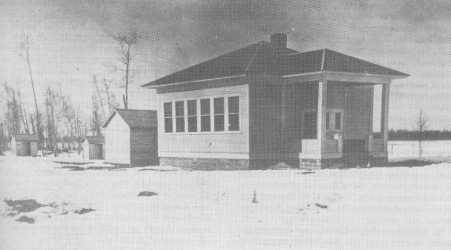
Rabey School, 1926
To the left are the toilets and woodshed.
Courtesy of Sylvia Eckstrom
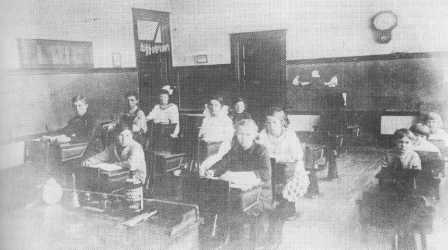
Inside the Rabey School
First and Second Grade teacher was Harriet Hoard.
Third Grade teacher was Mrs. Magenson.
Courtesy of Sylvia Eckstrom
In addition to religious functions, the school served as a social center for the community. "A basket social and dance was given at the Rabey school house where Miss Florence Young teaches school. It was quite well attended by the young men of this community but some of the young women thought it was too cold so only seven came and brought baskets. Lunch and coffee was served for twenty-five cents to all who didn't bring baskets. Twenty-five dollars and fifty cents were accumulated and are to be used in getting several different articles for the school. Everybody had a good time." (Grand Rapids Herald Review ~ February 9, 1916)
By 1916, Rabey's prospects looked bright. One newspaper account relates. "A new hostelry has just been opened and has been given the name of 'Dew Drop Inn'. Mr. Robert R. Meer is proprietor, clerk and chambermaid as well as bottle washer and hostler. Mr. Meer reports that business is good and that he is furnishing as good grub as can be gotten in any place in the country which bears the same name.

Local Men Working at Rabey, 1916
L-R: Harry Peterson, Carl Rasmussen, John Phillips,
George Good, R. C. Rasmussen.
Courtesy of Bob Hurt
"The Burt brothers have decided to move their mill to Rabey in the spring and have been guaranteed 100,000 feet of logs to cut. A. N. Phillips is hauling logs to the mill location.....Will Miller who recently purchased the Farm Development Co. farm is hauling lumber to Rabey to erect an ice house." (Hill City News ~ January 20, 1916)
It is said that Ruth (Phillips) Herrick, the daughter of Al Phillips, was the first white child born at Rabey which was on March 19, 1914. The Township of Ruth (of which Rabey was a part) was named after her. (Rabey History, by Sylvia Eckstrom) The township was organized on April 26, 1921. (Aitkin County Recorder's Office, book "D", page 280) In 1931 the township board consisted of Severt Sandin, clerk; F. A. Kaiser, William Wandschneider, and E. J. Hale, supervisors; A. K. Lukens, treasurer and assessor. In 1932, new officers were elected which consisted of Severt Sandin, clerk; J. B. Nichol, John Nordberg Sr. and F. A. Kaiser, supervisors, and M. J. Salisbury as treasurer for the town. (Aitkin Co. Land Department records, Rabey file.)
The first postmaster appointed at Rabey was Vane Walker who started on March 21, 1913. Chas. Kaiser took over on August 21, 1914 with Harold Eastman taking over that duty on October 27, 1915. (Per U. S. Postal Service records) John Rice was the first rural mail carrier from Rabey. He would travel one day into the Splithand area and then the next day towards Jacobson. After Rice, Mr. Wandschneider carried the mail and then Joe Murphy. (Rabey History, by Sylvia Eckstrom) The mail came via the railroad which carried it on down from Swan River.
By 1920, the people of Rabey and Splithand got together to organize a joint telephone company. On January 1, 1921, the Rabey Telephone Company was officially organized. (Per Rabey Telephone Company bylaws, dated January 1, 1921) It is not known just what the exact service territory consisted of other than the immediate Rabey area and some distance into the Splithand country. Bylaws were set up, and the company ran for a number of years.
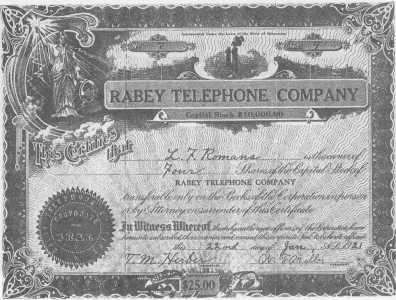
Rabey Telephone Company Stockholders Certificate
Courtesy of Bob Hurt
Warren Rabey thought he had invented the ultimate stump pulling and land clearing machine. The machine was said to be able to clear from an acre and a half to five acres a day according to the number and size of the stumps, windfalls and standing timber. The cost per acre was only $13.77. The cables with which the pulling and skidding were done would reach 200 feet from the machine. Five men were required to operate the machine, one to control it, with two on the pulling cable and two on the piling cable. The nice thing about this machine was that the stumps could be piled up to 20 feet in height while the machine was still busy pulling stumps. Rabey proposed to organize a company to build the machines, sell them or lease or operate them on land clearing contracts. The machine could clear land quickly and cheaply. (Per brochure by W. W. Rabey, dated 1921) The demonstration of the Rabey stump puller and piler, staged by the inventor, county commissioner W. W. Rabey, about a mile south of Hill City, on Friday last, attracted a large number of people. There were probably three to four hundred who witnessed the work of the machine during the day. Delegations were present from Shovel Lake, Remer, Swatara, Grand Rapids and Virginia. " (Aitkin Republican ~ October 6, 1921) It is not known why the machine did not go into mass production, despite the demonstrations that were given.
Al Philips had a large house to the north of Rabey. He built the big house because many of his workers stayed there. He raised a lot of potatoes and did some logging. He had gas lights in his house and a large root cellar for storing potatoes. Al also took in weary travelers. The minister always came out every Sunday for dinner. (Rabey History, by Sylvia Eckstrom)
Harold Eastman called his store the Rabey Mercantile Company or the Eastman Store. One account relates, "Mr. Eastman will be in charge of the business at Rabey and expects to be opened up the latter part of the week. The new company takes over the store of the Farm Development Company, which concern will devote all its energies to developing the farm."(Hill City News ~ January 14, 1915) Eastman built a house and later built the large barn that for years was owned by Nels Hyen. (Per interview with Charlie and Grancille VanDusen on November 11, 1995)
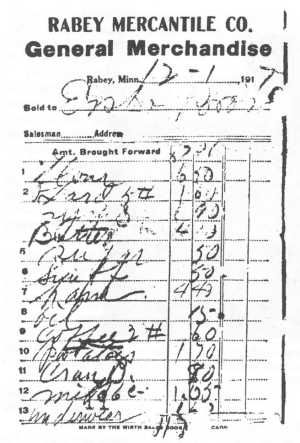
Rabey Mercantile Receipt
Courtesy of Aitkin County Land Department
Eastman later sold his store to Amos K. Lukens in 1922. "Col Lukens has purchased a new 550 barrel gasoline storage tank and an up to date pump. These fixtures will soon be installed near the new store." (Hill City News ~ September 28, 1922) Lukens also ran the train depot for a few years.
Rudy Brandenburg set up a store as well. Rudy sold groceries and gas but no beer. He closed down his store in the early thirties and just kept the post office. He then sold the post office business to Hub Hudson. Hub took over about 1934. (Per interview with Betty (Larson) Leppanen on April 17, 1996) They ran a store and had dances where the post office used to be. (Rabey History, by Sylvia Eckstrom)
About 1920, Maurice Salisbury came to Rabey. Salisbury first came to Aitkin where he worked as a bank teller. Salisbury then went to work at Ball Bluff where he worked at buying timber from the farmers of that locality. He saw an opportunity at Rabey and so he started running a pole yard there. He sold mining timbers to the mines and had them shipped out over the Hill City Railroad. Having established a good rapport with the farmers of the Ball Bluff area, he had a good following, and he treated them well in return. There was talk of establishing a bank at Rabey which interested Maurice. "A number of people in the southern part of Itasca County are interested in the project of a new bank, which it is proposed to establish in Rabey. The business men located in Rabey, and the farmers in the territory adjacent, have felt for some time that there was an opportunity for a bank in that village, and have made the necessary moves to get one started.
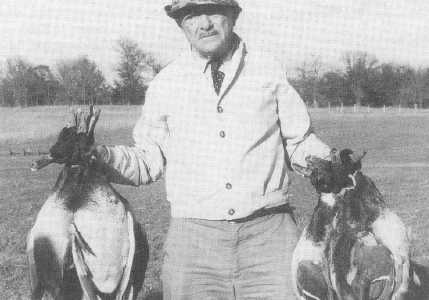
Maurice Salisbury
Courtesy of Virginia Wilcox
"The hearing before the state securities commission will be held in St. Paul today. Several men from Rabey and Splithand are in St. Paul to attend the hearing, among them being H. V. Eastman, A. B. Feero, A. N. Phillips and William Jackson. They express little doubt of the approval of the project, and of securing the charter necessary before opening business.
"James Annand, of St. Paul, recently visited in Rabey for several days with the view of becoming cashier of the bank, if it was established. He was very favorably impressed with the agricultural possibilities of the southern part of Itasca County, and the district tributary to Rabey, and declared his willingness to locate there." (Grand Rapids Herald Review--April 7, 1920) In those days banks were easy to get started as you needed only $10,000.00 capital and $2,000.00 surplus to obtain a bank charter. (The Rabey Line, by Robert Lemen, page 27) The state securities commission must not have been as upbeat about the location, as the charter was not granted to Rabey.
For a time, Salisbury had the only phone at Rabey, which was a line running to Hill City. He then got a phone with the Rabey exchange. One local resident told of his experience with Salisbury. "We used to go to Rabey with horses following the ditch bank trail from the west side of the Mississippi River about five miles south of highway #34. We went west and then north and on to Rabey. That road was known by the locals as 'Fart Creek Road.' Mr. Salisbury had set up a business at Rabey of buying wood from the farmers of the area. He would let out the word that he was looking for cedar posts, spruce poles or ties. We would bring them in and he would cut us a check. He was a good man to deal with and was always fair. (Per interview with Victor Bjorkquist on August 6, 1995)
About 1934, Maurice Salisbury went into business with Vietti (Vic) and Ole Mannila, who had a sawmill at Jacobson. Maurice was mainly a silent partner and provided financial help as well as business for the mill. Vic and Ole had a steam tractor to run the mill. This was the site where the power plant was set up for the mill and also for several businesses in Jacobson. They were their own electric company for a few years until the R.E.A. came to town. The Manilla boys bought out Maurice's interest in the mill and moved to Big Falls. (Per interview with Doug Salisbury on February 16, 1996) Maurice moved in 1937 to Grand Rapids and started buying timber for the Blandin Paper Company.
The Rabey community had a baseball team in the twenties which played against Verdon, Palisade, Swatara, Jacobson and Hill City. The Hill City News reported with dismay their loss to Rabey. "The Hill City Cubs put up a hard fight during the game they played with Rabey last Sunday. The score was 9 to 5. Roy VanDusen, pitching for Rabey had plenty of speed but not much control over the ball. Our boys had no subs so it was a rather hard game for them as two men were laid out after the first half, leaving only seven to finish the game. Our pitcher, Joe Dupont, pitched a good game all the way through. The boys are going to be better prepared when Rabey comes here for the return game." (Hill City News--June 30, 1921)
Rabey experienced its share of crime as well. "The post office at Rabey was robbed recently and over $250.00 of post office funds were taken. Maurice Salisbury, formerly with the Farmers National Bank of Aitkin, who is postmaster, occupies part of the A. K. Lukens store building, and when Mr. Lukens arrived at the store Friday morning he found a side door open and the safe plundered. Mr. Lukens was in Aitkin with his family for the week end and was not able to say just what was taken from the stock of goods. He could give no clue to the robbers." (Grand Rapids Herald-Review--May 23, 1923)
One paper tells the story of the progress that Rabey was making. "Rabey is located on the Hill City line twelve miles east of Hill City and 19 miles south of Grand Rapids. While still comparatively new, ten years ago a forest stood on the present town site and there were no roads of any kind leading to it. The quality of the land in and about Rabey and the ease with which it could be cleared and placed under plow induced many land seekers to establish themselves in that locality and has resulted in the building up of a prosperous farming community with a very promising future.
"I. P. Best of Davenport, Iowa, the largest active landholder in the community has some 1,800 acres which is rapidly being improved and when the time comes will be placed upon the market. Mr. Best is now placing under plow the entire east side of section eight just west of Rabey and plans to have a field some over a mile in length extending across this section and into the section joining it on the north. This in addition to improvements on other portions of his land in vicinity.
"A fine modern hip-roof barn has been erected this summer in 'Village View Farm' owned by M. J. Salisbury which is located just a quarter mile north of Rabey.
"Farmers in the Rabey neighborhood are all active getting more land under cultivation and making general improvements to their farms and it is not difficult to predict that a very few years will see a material advance in the prices of farms located there.
"A new road to be designated as State Road No. 4 and known as the Hill City and Hartley road is under construction. This road leads from State Road 35 through Hill City and Rabey to Island Farm connecting there with the Floodwood road to Duluth and this will place Rabey at a distance of about 68 miles from Duluth by excellent auto road. Two rural mail routes operate out of Rabey and some 100 farmer patrons are served. At the last election the township board was authorized by the voters to construct a township hall to be used by the community for various functions." (Hill City News--September 3, 1925)
The influence of the K.K.K. even found its way to Rabey. "A Ku Klux Klan meeting was held at Rabey Monday evening. About 50 cars of people were present coming from Swan River, Jacobson, Hill City, Splithand, Grand Rapids and Aitkin. It was an outdoor meeting. The principle speakers were Rev. Cartwright, the Methodist pastor of Hill City and Mr. Randall who came from Aitkin where he has been for several weeks." (Aitkin Republican--August 12, 1926)
It was a sad event when Luken's Store burned in 1928. "Luken's store at Rabey lies a total loss from fire Sunday, according to reports from that village. The entire building and contents burned to the ground, there being no adequate means of fighting so large a blaze there. The building and contents were the property of A. K. Lukens formerly of Aitkin, who for several years past has operated a general store and lived at Rabey. Reports are that there was considerable insurance to offset so complete a loss. It is thought an overheated stove caused the blaze." (Hill City News--January 5, 1928)
Charles and Amy Porter moved to a farm near Rabey in 1934. Amy started a club called the "Rabey Helping Hand Club." This club was like a sunshine club and did whatever they could to make people feel welcome in the community.
Henning Larson moved to Rabey in 1936 and ran a store where Salisbury had his home and office. When Larson left the store in 1942, he sold to Johnny Thiel who, along with a friend Dolly, ran it. After that John Thiel's mother and her husband Herman Apel came to run the store. The store burned to the ground and so Herman bought the house that Rudy Brandenburg used to live in and moved it closer to the highway and ran a store out of there for a while. The house was later sold to the state. (Rabey History, by Sylvia Eckstrom)

Ferry North of Jacobson near Hill City Railroad Trestle
Courtesy of L. L. Taylor via Bill and Esther Lange
The Rabey area began its decline after the railroad was pulled up in 1935. Business dwindled, and the only commerce traveled over the dirt roads to Splithand or the graveled State Road #34. The Rabey depot was sold to Wayne Michelson for $15.00 in 1935. He moved it along with the Seaver potato warehouse to his farm along the River Road just south and east of where the grade crossed the River Road. (Per letter from Pearl Michelson, dated October 5, 1996) The Township of Ruth could go on no longer and so was dissolved on June 15, 1937. (Per Aitkin County Recorder's Office, book "G", page 306)
Herbert Hudson was the last postmaster at Rabey. The post office was closed on July 23, 1941. (Per U. S. Post Office records.)
In 1944, the state health department wanted the local school board to put down a well and install inside plumbing. The school board at that time consisted of Jake Nordberg as clerk, Lee Feero as treasurer, and Victor Bjorkquist as chairman. The board didn't feel the district could afford the costs of the work needed and so the school was closed. (Per Rabey History, by Sylvia Eckstrom) The school house was sold to Earl Lipscy of Hill City in 1950. Earl sold the building to Harold Mento who tore the building down and built a home out of it on the River Road.
Still another fire destroyed a part of Rabey. "Early morning fire completely destroyed the store building and stock belonging to John Thiel at Rabey. Cause of the fire was not learned but it appeared to have started in the front part of the store at about two o'clock in the morning.
"At 2:30 a call fro help came to the forestry office and a crew was hurriedly summoned and they went to the scene of the fire as quickly as possible. However, the fire had got such a start and the building burned so fast that very little could be done in salvaging any of the contents of the building or putting out the fire so as to save the building.
"Living quarters in the same building together with the household goods were also destroyed. No report has been received as to the amount of the loss, but it was a total loss both as to the building and the stock of goods. The fire, which had apparently started about two o'clock, or shortly thereafter, quickly swept through the frame structure so that efforts to fight the blaze or salvage the contents of the building were unavailing." (Hill City News--April 15, 1948)
When the state decided to improve Highway #34 (200) in the 1950's, they built the road right through the town site of Rabey. The state bought up the houses that were in the way and then resold them to people who moved them out of the way.
The last building to go at Rabey was the potato warehouse. The building eventually collapsed from heavy snow one winter. Warren Porter then burned the building to prevent anyone from being hurt in the ruins.
Today the average traveler would not notice the former site of Rabey as having been a place of importance. All that remains is the old Nels Hyen farm on the south side of Highway 200. The railroad is gone and is now used as a popular snowmobile trail in the winter. A few farms still exist to the north as one travels towards the Splithand country. Nature is reclaiming many of the farms that existed near Rabey. The village of Rabey served its purpose in a simpler and more peaceful time. The memories live on and as one passes through, a bit of nostalgia sweeps along as we remember the pleasant days of Rabey.

BACK
HOME